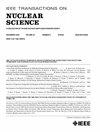Design and Characterization of a Radiation-Tolerant Wireless Physical Layer for Control Applications in CERN Particle Accelerators
IF 1.9
3区 工程技术
Q3 ENGINEERING, ELECTRICAL & ELECTRONIC
引用次数: 0
Abstract
The article explores the design and radiation characterization of a wireless physical layer (PHY) specifically tailored for equipment control in harsh radiation environments, such as those in particle accelerators like the large hadron collider (LHC). The PHY, built with commercial-off-the-shelf (COTS), leverages a software-defined radio (SDR), which, compared to dedicated transceivers, provides more flexibility and enables enhanced reliability through mitigation techniques. It is designed for low latency to meet the sampling time requirements of current LHC control applications. The PHY is developed to be radiation-tolerant, capable of withstanding the LHC radiation environment. The article presents the radiation characterization of all system components using a 200-MeV proton beam. Experimental results show the link’s robustness against total ionizing dose (TID) and single-event effects (SEEs), with no performance degradation due to SEEs and tolerance up to kGy of dose. Radiation-induced link losses were observed, and strategies to enhance link reliability were discussed.欧洲核子研究中心粒子加速器控制应用的耐辐射无线物理层设计与特性分析
本文探讨了无线物理层(PHY)的设计和辐射特性,该物理层专门为恶劣辐射环境下的设备控制量身定制,例如大型强子对撞机(LHC)等粒子加速器中的设备控制。PHY采用商用现货(COTS)构建,利用软件定义无线电(SDR),与专用收发器相比,它提供了更大的灵活性,并通过缓解技术提高了可靠性。它被设计为低延迟,以满足当前LHC控制应用的采样时间要求。PHY具有耐辐射能力,能够承受LHC的辐射环境。本文介绍了用200兆电子伏特质子束对系统各部件的辐射特性。实验结果表明,该链接对总电离剂量(TID)和单事件效应(SEEs)具有鲁棒性,且不会因总电离剂量和高达kGy剂量的耐受而导致性能下降。观察了辐射引起的链路损耗,并讨论了提高链路可靠性的策略。
本文章由计算机程序翻译,如有差异,请以英文原文为准。
求助全文
约1分钟内获得全文
求助全文
来源期刊

IEEE Transactions on Nuclear Science
工程技术-工程:电子与电气
CiteScore
3.70
自引率
27.80%
发文量
314
审稿时长
6.2 months
期刊介绍:
The IEEE Transactions on Nuclear Science is a publication of the IEEE Nuclear and Plasma Sciences Society. It is viewed as the primary source of technical information in many of the areas it covers. As judged by JCR impact factor, TNS consistently ranks in the top five journals in the category of Nuclear Science & Technology. It has one of the higher immediacy indices, indicating that the information it publishes is viewed as timely, and has a relatively long citation half-life, indicating that the published information also is viewed as valuable for a number of years.
The IEEE Transactions on Nuclear Science is published bimonthly. Its scope includes all aspects of the theory and application of nuclear science and engineering. It focuses on instrumentation for the detection and measurement of ionizing radiation; particle accelerators and their controls; nuclear medicine and its application; effects of radiation on materials, components, and systems; reactor instrumentation and controls; and measurement of radiation in space.
 求助内容:
求助内容: 应助结果提醒方式:
应助结果提醒方式:


